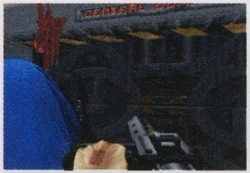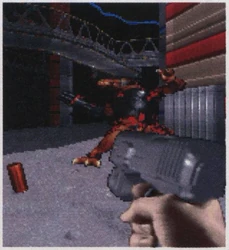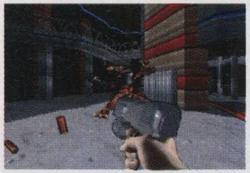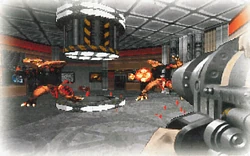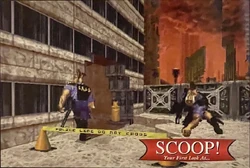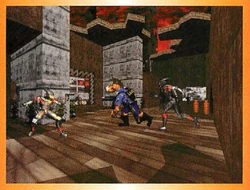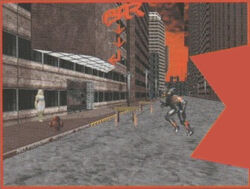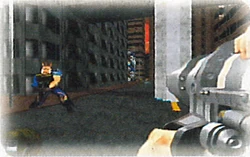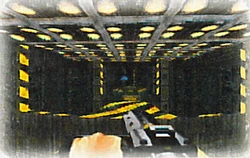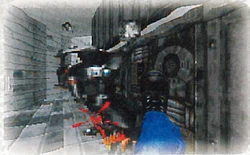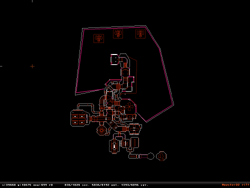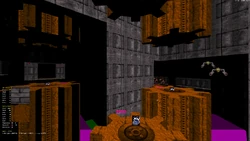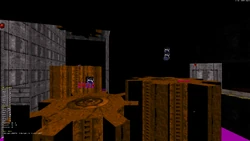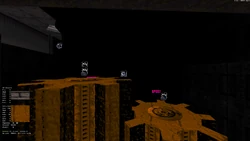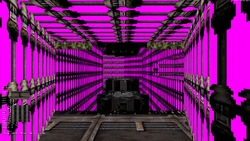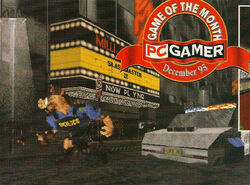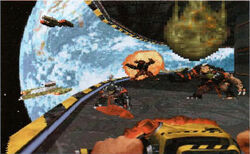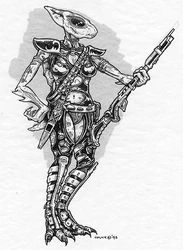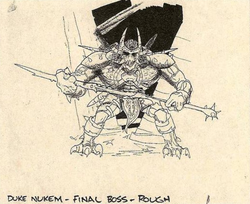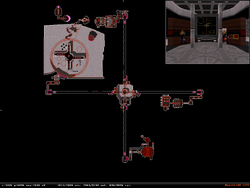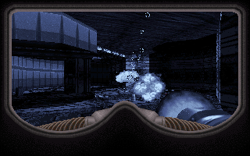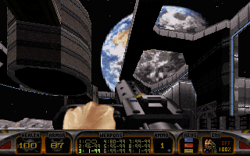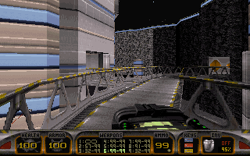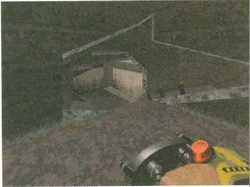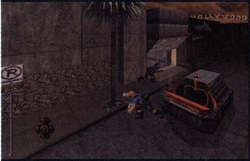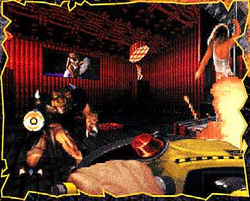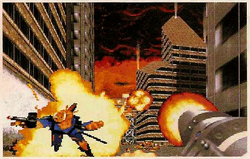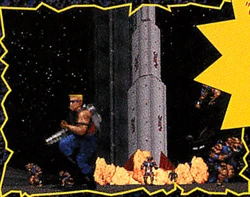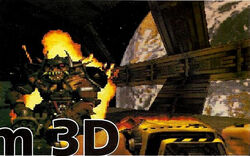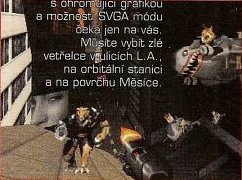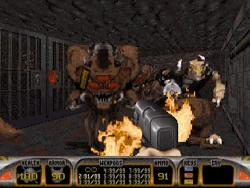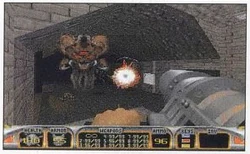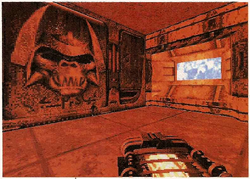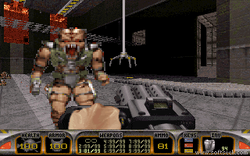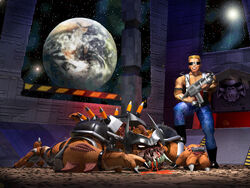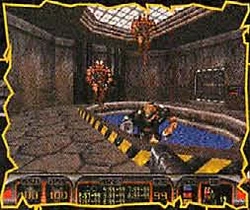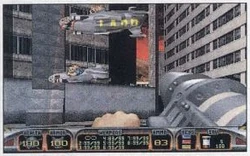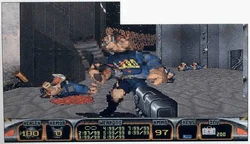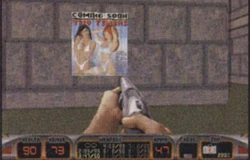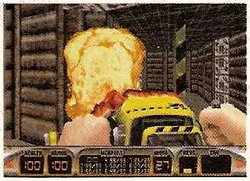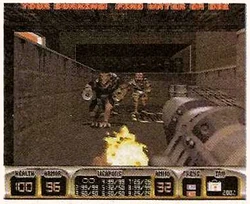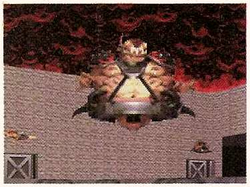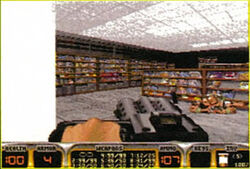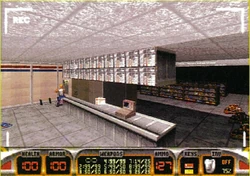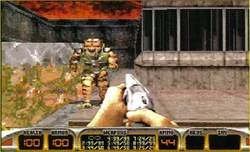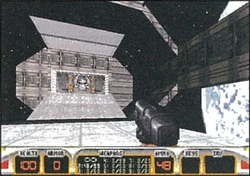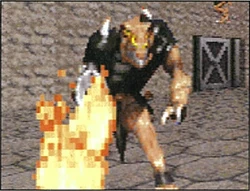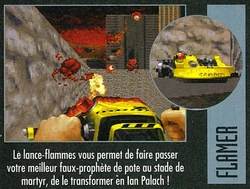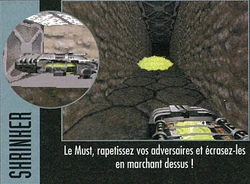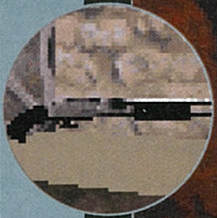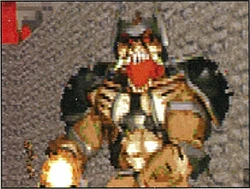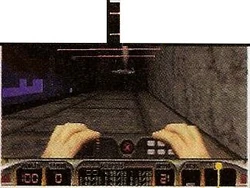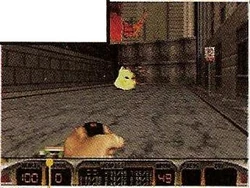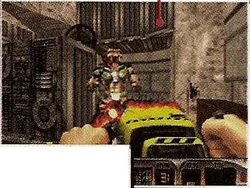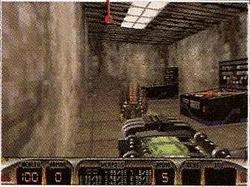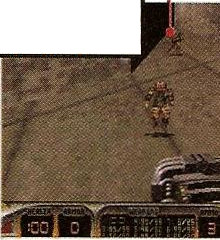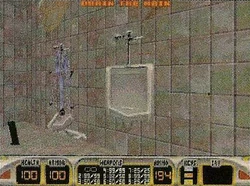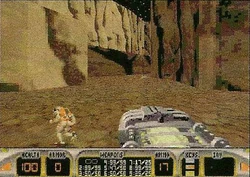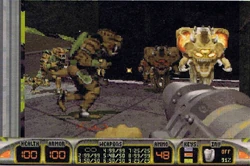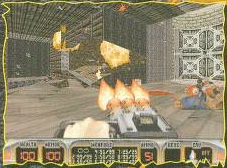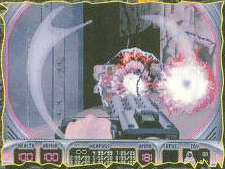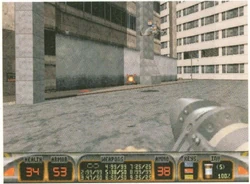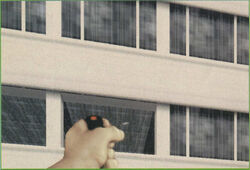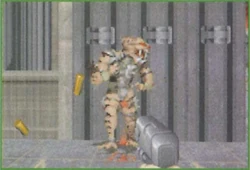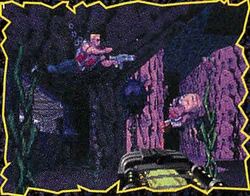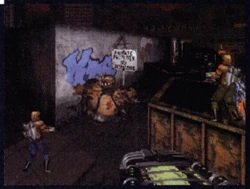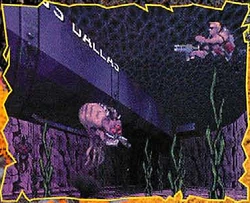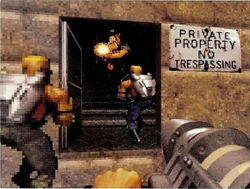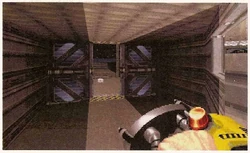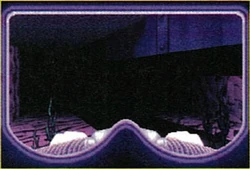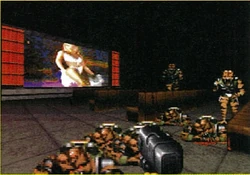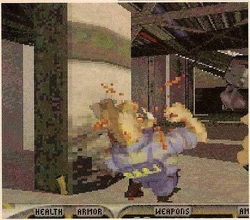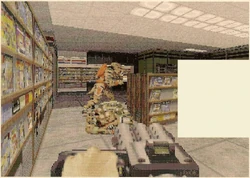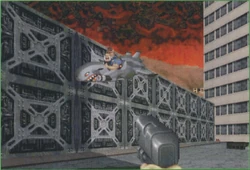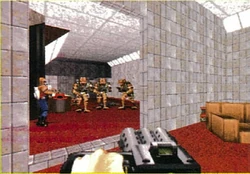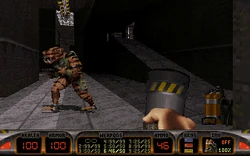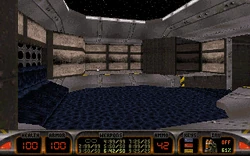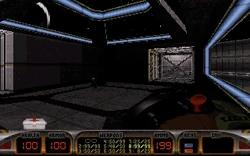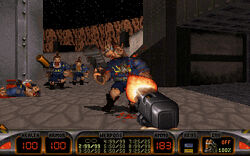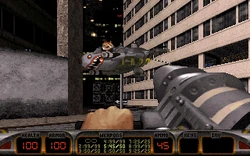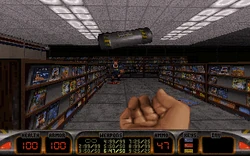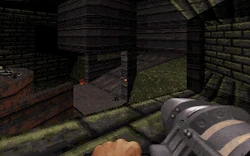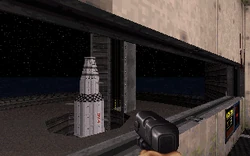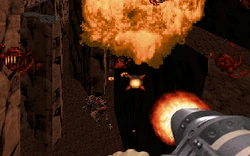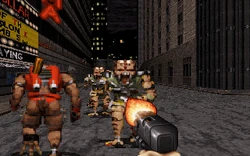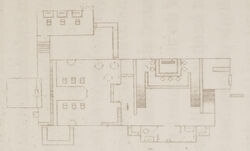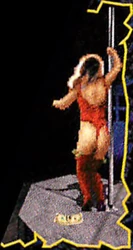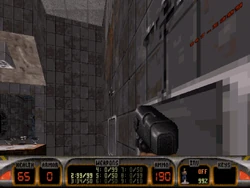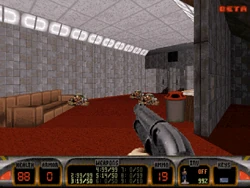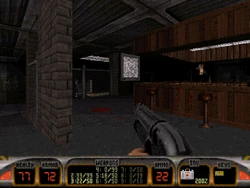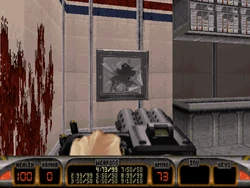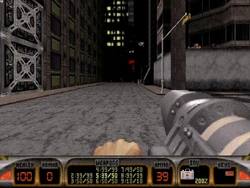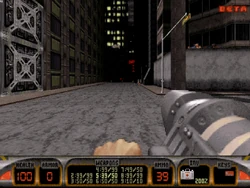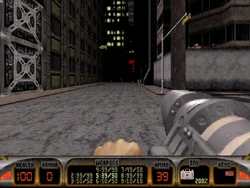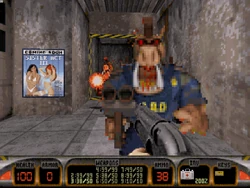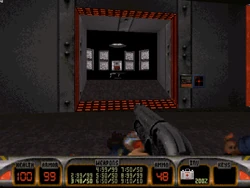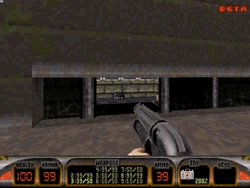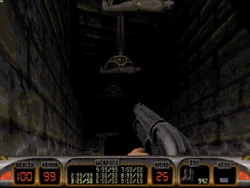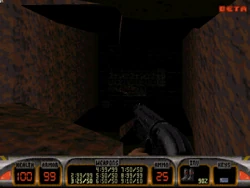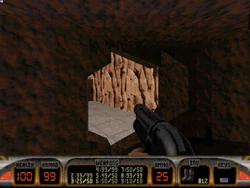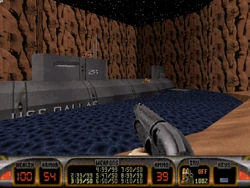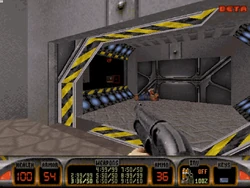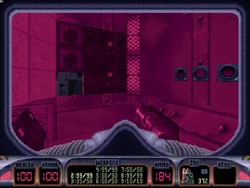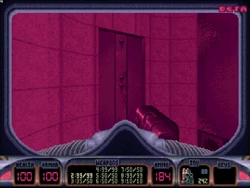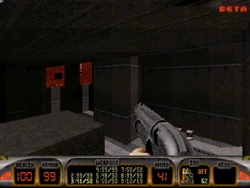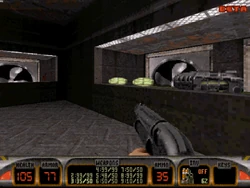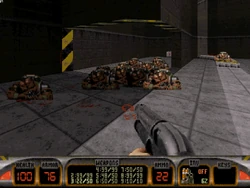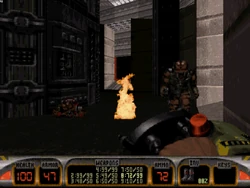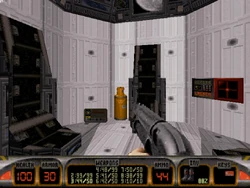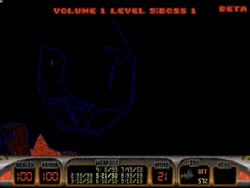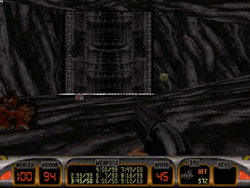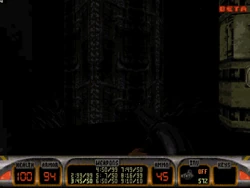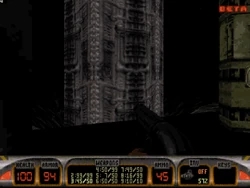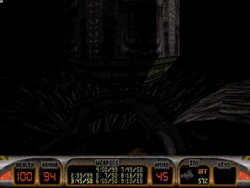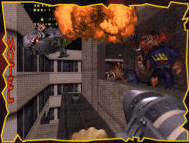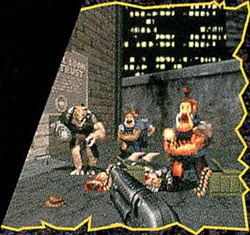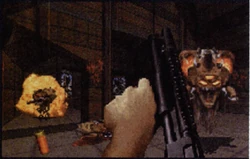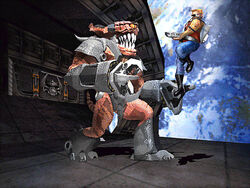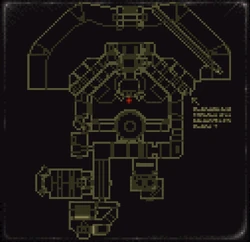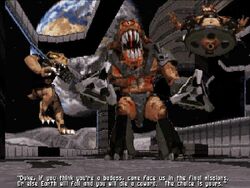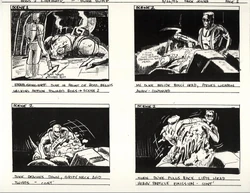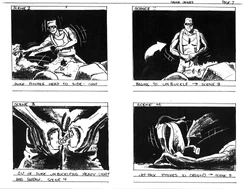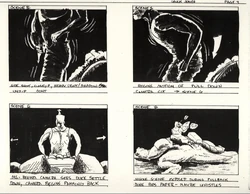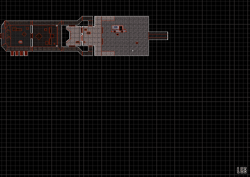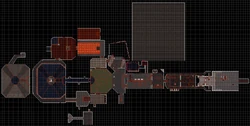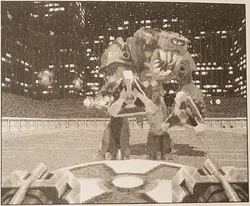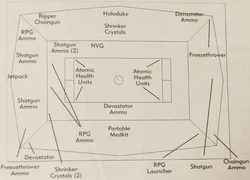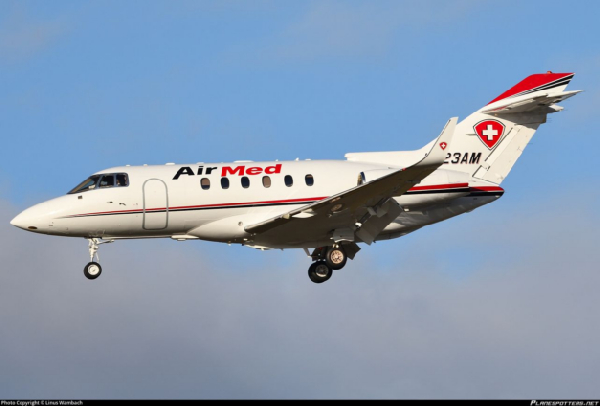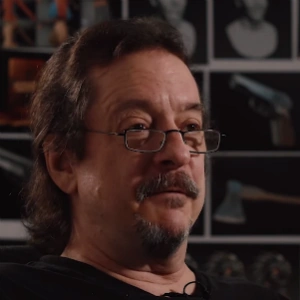Duke Nukem 3D prototypes
- Note from the admin: This article is a continuous work in progress and may contain errors. If you have good reason to believe anything in this article is mistaken, please make a correction and explain your reasoning. All visitors are welcome to contribute new material to this article.
Title screen, circa 1995
The Duke Nukem 3D prototypes are builds of Duke Nukem 3D, Duke Nukem 3D: Atomic Edition, or Duke Nukem 3D: 20th Anniversary World Tour that precede their commercial releases. Several of these builds have either been leaked or officially released as freeware. However, most are only known from screenshots or demo footage.
According to the game's lead director and executive producer George Broussard, Duke Nukem 3D began development in 1994. Timestamped materials from extant sources show that development could not have started prior to January 2, 1994 and yet development was well underway by March 19, 1994. In the beginning, the game was known simply as "Duke Nukem III", and the development team, operating as an independent studio within Apogee Software, was known as "Core Software".
The initial conception of Duke Nukem 3D was not only heavily influenced but directly inspired by Doom. As early as March 1993, Doom was one of the most highly anticipated games of the year. At that time, the first Doom demo would not be available for another 9 months, but fans were already excited by Id Software’s pre-release screenshots, which were branded as the next project by the creators of the highly acclaimed Wolfenstein 3D. In fact, Ken Silverman compiled a computer program on March 6, 1993 that would allow him to view the pre-release screenshots on his computer. Having just recently published Ken’s Labyrinth through Apogee Software, Silverman casually mentioned to Scott Miller, the CEO of Apogee, that he wanted to adapt his 3D game engine from Ken’s Labyrinth to create a “Doom-style engine.” Miller, who wanted his studio at Apogee to develop a first-person shooter of their own, reached out to Id Software with a request to license their game engine, but Id Software declined. On March 30, 1993, Miller wrote a letter to Silverman, congratulating him on the commercial success of his new game and, in a sly reference to Silverman’s previously declared interest in developing a first-person shooter engine, noted that Id Software was not allowing anyone else to use their engine. Around this time, it was determined that hiring Silverman would be Apogee’s “next best option.” On April 13, 1993, Silverman created the file directory for a new game engine he titled “Build” because, in his own words, “I just needed to pick a name.” By August of that year, Silverman was receiving bug reports and feature requests from George Broussard, the creative director at Apogee Software who was monitoring Silverman’s progress on the new engine.
On December 3, 1993, Apogee Software published Duke Nukem II. One week later on December 10, Id Software published Doom. According to George Broussard, Duke Nukem 3D began development in 1994 as an attempt at merely copying features from Doom, a version of events partly corroborated by Ken Silverman. Taken at face value, Broussard’s statement would mean that development of Duke Nukem 3D could not have begun before January 1994. Broussard’s recollection of a 1994 start date is plausible given the December publication dates of Duke Nukem II and Doom, considering that the timing of American holidays likely would have delayed Todd Replogle and Allen Blum — who are credited as the co-creators of Duke Nukem II and Duke Nukem 3D — from starting an entirely new project. In addition, Silverman had not even incorporated sectors – the most basic unit of the game engine – into Build until January 2, 1994, so it is unlikely that the Build engine would have been available to Replogle and Blum to begin planning their 3D game any time before January.
Main Article: Nukeland (L9)
Nukeland is believed to be the first map, if not the first game asset, developed specifically for Duke Nukem 3D. In the change log packaged with the April 1994 Build demo on Ken Silverman's website, Silverman describes Nukeland as "my board" and uses it to demonstrate new features of the engine described in his revision notes, some of which are specifically addressed to the "Duke Nukem III team". Although the first revision notes in the change log are dated February 6, 1994, there is not enough information to infer the start date of Duke Nukem 3D's development, since Apogee is known to have licensed the Build engine to the Blood development team even earlier than the Duke Nukem team. However, judging by the map's title, Nukeland was apparently a demo map that Silverman had designed specifically for the Duke Nukem team, making it very likely that the map was shown to the team as part of their first introduction to the engine.
A fork of Nukeland with minimal changes would later appear in the December 1994 prototype, indicating that the developers clearly considered this a Duke Nukem map. The version packaged with the prototype, titled "L9.MAP", showed that the developers were using it to test the game's security camera functionality, which was not included in Silverman's core engine but was added by Todd Replogle. Based on their off-kilter, duplicative placement, it can be inferred that the security cameras did not yet function the same way as seen in later beta footage from April 1994, which strongly suggests this was the first map where the security cameras were being tested.
In the footage below, the video on the left shows the fork of Nukeland that was packaged with the April 1994 Build demo, and the video on the right shows the fork that is included in the December 1994 prototype of Duke Nukem 3D. Neither version is "older" than the other; both are forks with unique modifications from an older iteration of the map.
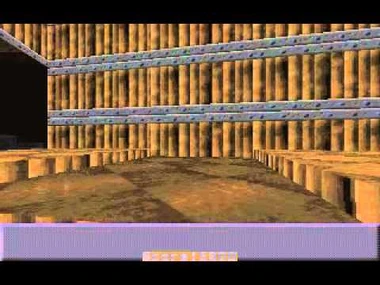 BUILD Engine (April 1994) |  Duke Nukem 3D beta (Lame Duke) L9.MAP (with corrected textures) |
As a test map, it is unlikely that Nukeland is related to any map in the final game. However, a very tentative case has been made that Nukeland could plausibly have evolved into Faces of Death; in addition to sharing a few key geometric measurements, the sector chronology of Faces of Death is consistent with the map having once been an homage specifically to Ken Silverman, before later becoming an homage to the entire development team. Because the level designers were working with grid-based increments and because the two maps have such simple geometry, it is hard to establish or rule-out a definitive link between the two maps. (See Nukeland (L9)#Faces of Death for more information)
In the Duke4 forums, a few individuals with privileged access to development files have shared what they believe to be the oldest Duke Nukem 3D map to survive into the final game: Stadium. A screenshot was posted from the oldest archived iteration of the map. Because it features such a minimalist design and experimental shapes that seem out of place, it is possible this was one of the first maps Allen Blum created in order to familiarize himself with the Build engine.
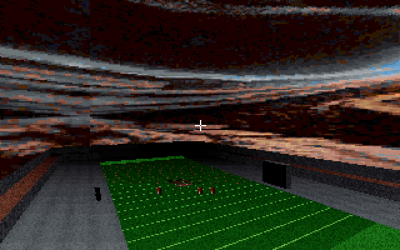 Earliest build of Stadium, circa Q1 1994 | 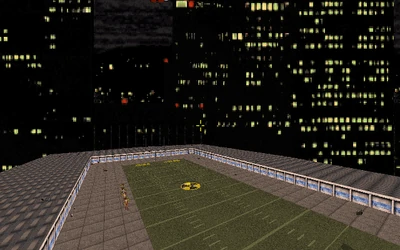 Final 1996 build |
In the change log packaged with the April 1994 Build demo, Ken Silverman wrote in his revision notes dated March 19, 1994:
For Duke Nukem III team: CITY.MAP will not crash anymore with new version. The reason it crashed was because in your TILES.ART, you had either ANMFD:0, ANMBK:0, or OSCI:0. That caused a MOD 0 in my animation routine. I bullet-proofed that. How about fixing tiles #34, #112, or #114 in your TILES.ART.
Given that the developers apparently had a map resembling a city and at least 114 graphics, it can be inferred that development was well underway by this point. Although the identity of "CITY.MAP" cannot be known for certain, it very likely corresponds to L6, a sprawling cityscape that uses almost the maximum map size permitted by early versions of the Build engine. As confirmed in the 20th anniversary developer commentary, Hollywood Holocaust and Red Light District were derived from two subsections of L6. There are no known screenshots from L6 or any other contemporaneous map from this time period.
Main Article: Duke Nukem IIID
In 2014, 3D Realms released footage from an early prototype of Duke Nukem 3D. In the video, the name "Duke Nukem IIID" appears at the top of the in-game menu. Richard "TerminX" Gobeille and Evan "Hendricks266" Ramos, both of whom signed non-disclosure agreements and were given an archive of Duke Nukem 3D development data, have identified this prototype as the earliest build of the game. Ramos, who actually recorded the footage, affectionately nicknamed the prototype "LamerDuke" because it preceded the December 1994 prototype, officially known as LameDuke. Gobeille later disclosed that the prototype in the video dates to April 1994.
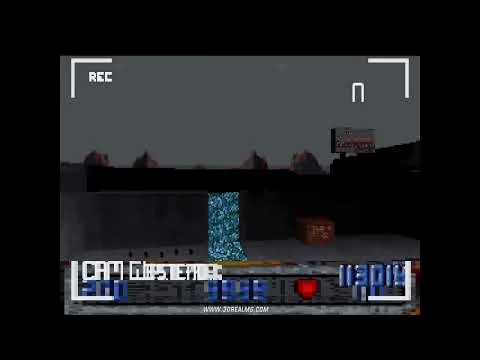
Duke Nukem IIID
Early concept art for the Jellyfish is dated November 7, 1994.
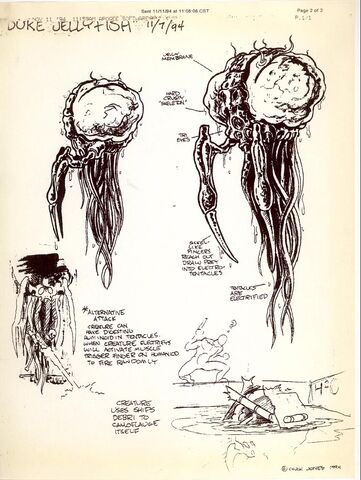
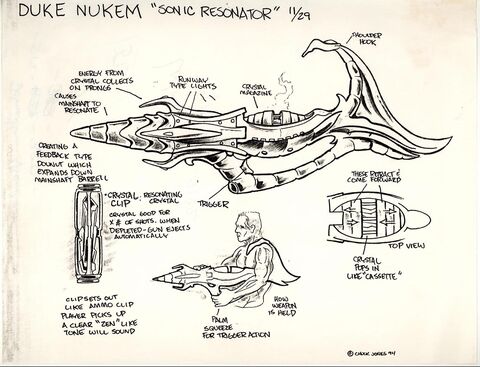
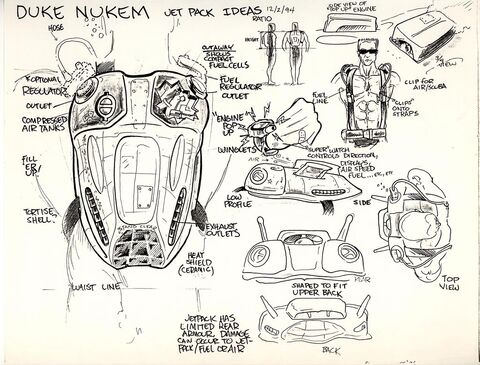
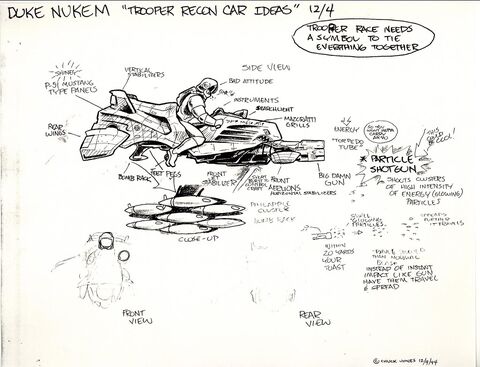

See Also: LameDuke
The December 1994 prototype, officially known as LameDuke, was finished and compiled on December 30, 1994.
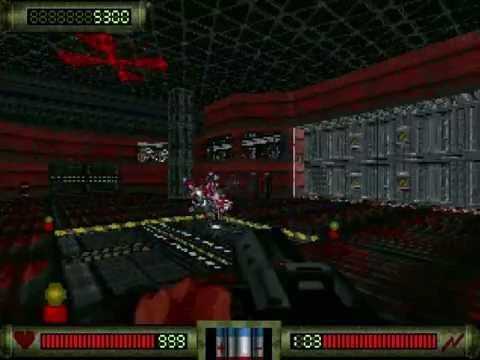
LameDuke Playthrough by Max Ylitalo
The table below summarizes the suspected relationships between maps in LameDuke and later maps from the Duke Nukem 3D development team.
| Relationship* | Later Map | Status† | |
|---|---|---|---|
| L1 | iterated | AHB-Space | confirmed |
| iterated | Spaceport | confirmed | |
| absorbed | Fusion Station | confirmed | |
| absorbed | Occupied Territory | confirmed | |
| absorbed | Tiberius Station | confirmed | |
| absorbed | Lunar Reactor | confirmed | |
| absorbed | It's Impossible | weakly supported | |
| not split | Tiberius Station | strongly supported | |
| not split | Lunar Reactor | strongly supported | |
| L2 | iterated | Dark Side | confirmed |
| absorbed | Fusion Station | weakly supported | |
| L3 | absorbed | AHB-Space | strongly supported |
| absorbed | Spaceport | strongly supported | |
| absorbed | Fusion Station | strongly supported | |
| absorbed | Tiberius Station | weakly supported | |
| absorbed | Dark Side | strongly supported | |
| absorbed | Duke-Burger | weakly supported | |
| L4 | iterated | Fusion Station | weakly supported |
| absorbed | Lunar Reactor | confirmed | |
| L5 | forked | Incubator | strongly supported |
| forked | Rabid Transit | confirmed | |
| forked | Babe Land | strongly supported | |
| L6 | split | Hollywood Holocaust | confirmed |
| split | Red Light District | confirmed | |
| split | Bonaventure test map | confirmed | |
| absorbed | Freeway | confirmed | |
| not split | Freeway | strongly supported | |
| L7 | iterated | Warp Factor | strongly supported |
| absorbed | It's Impossible | strongly supported | |
| L8 | scrapped | ||
| L9 | iterated | Faces of Death | weakly supported |
| not forked | Zoo | strongly supported | |
| M1 | iterated | Freeway | strongly supported |
| forked | M2 | confirmed | |
| absorbed | Toxic Dump | weakly supported | |
| absorbed | Launch Facility | strongly supported | |
| M2 | forked | M3 | confirmed |
| M3 | recreated | Launch Facility | weakly supported |
| M4 | scrapped | ||
| not iterated | Duke-Burger | strongly supported | |
| M5 | iterated | Critical Mass | confirmed |
| absorbed | Occupied Territory | weakly supported | |
| M6 | iterated | Hotel Hell | confirmed |
| M7 | absorbed | Fusion Station | strongly supported |
| not absorbed | Critical Mass | strongly supported | |
| M8 | iterated | N8 | confirmed |
| N1 | iterated | Death Row | confirmed |
| N2 | iterated | Derelict | confirmed |
| forked | N3 | confirmed | |
| N3 | absorbed | Dark Side | strongly supported |
| N4 | scrapped | ||
| N5 | scrapped | ||
| N6 | iterated | Toxic Dump | strongly supported |
| absorbed | Death Row | strongly supported | |
| N7 | absorbed | Freeway | strongly supported |
| absorbed | Bonaventure test map | weakly supported | |
| N8 | absorbed | Overlord | confirmed |
| not iterated | Overlord | strongly supported | |
| O1 | absorbed | Babe Land | weakly supported |
| absorbed | Sweeney | weakly supported | |
| O2 | scrapped | ||
| O3 | recreated | L3 | weakly supported |
| O4 | iterated | O2 | confirmed |
| WAR1 | iterated | O1 | confirmed |
| WAR2 | scrapped |
*"Iterated" means the later map was directly developed from the earlier map. "Split" means the earlier map was divided into subsections, each of which was directly iterated into a later map. "Forked" means multiple maps were directly iterated from different versions of the earlier map. "Absorbed" means parts of the earlier map were copied-and-pasted into an already existing version of the later map. "Recreated" means the later map was started as a second draft of the earlier map, possibly to correct for design limitations or performance issues.
†"Confirmed" means either that the relationship has been acknowledged by individuals with privileged access to development files or that the relationship can be easily verified due to perfect alignment across large-scale geometric spaces. "Strongly supported" means there are multiple lines of concrete evidence, such as sector chronology, geometric measurements, matching z-coordinates, matching textures, or beta screenshots, with little or no known evidence to the contrary. "Weakly supported" means there may be significant contradictory evidence, or the relationship may be primarily based on thematic similarities and abstract arguments, rather than concrete evidence.
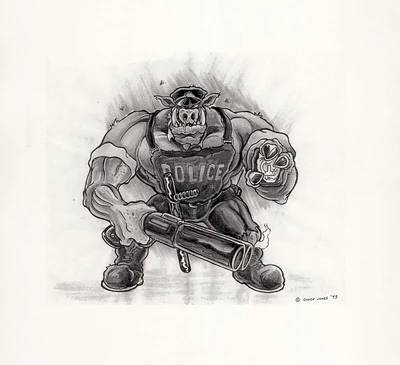 Pig Cop by Chuck Jones | 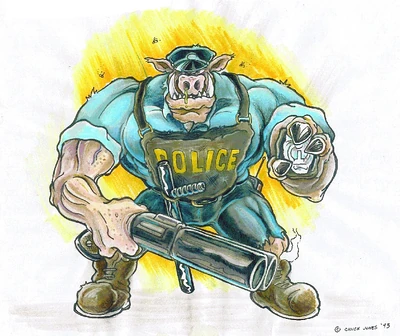 Later colorization by Chuck Jones himself |
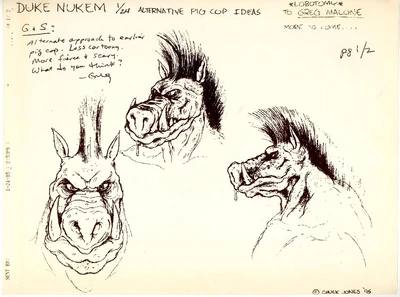 Pig Cop | 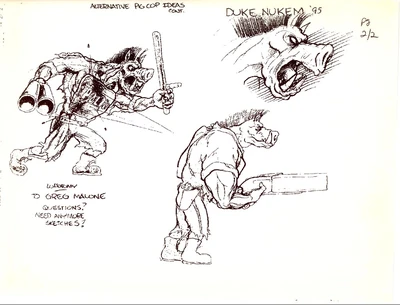 Pig Cop |

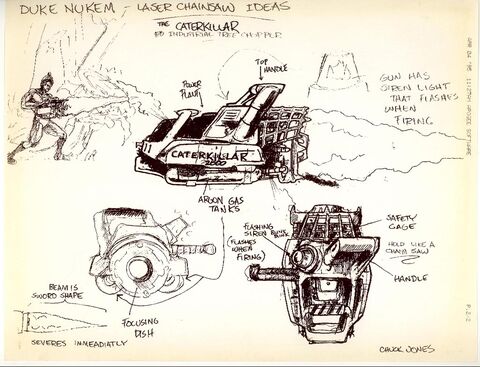
Duke has a scar on the back of his left hand. The Pistol uses the faded sprite from LameDuke. The Tazer has not yet been replaced with the Mighty Foot.
Duke Nukem II checkpoint on Dark Side (compare to Duke Nukem II sprite; the white horizontal line is actually a ledge in the distance) [Note: There is reason to think this may have been developed separately on N3 before later being absorbed into Dark Side]
Far corner after dropping down the elevation near the end of Dark Side, facing the elevation with a box on the left [Note: There is reason to think this may have been developed separately on N3 before later being absorbed into Dark Side]
Beneath the "Central Command" door on AHB-Space
O1, apparently repurposed as a staging map to showcase new enemies
O1, unchanged except that plants and new enemies have been added (Note: Sector effector sprites can be seen in the doorway and near the ceiling above the elevator)
L6, facing the building that would become the club on Red Light District (the adult-themed store has not yet been expanded to subsume the street)
Three of these images come from the June 1995 issue of Joystick (#61), and two come from an individual with privileged access to development files. The scar on Duke's hand has been removed, and the Tazer has been replaced with the Mighty Foot.
L6, standing between what would become the club (left) and adult-themed store (right) on Red Light District as seen in this video, with the first appearance of the flashlight in the bottom-left corner
Unidentified. The textures are a close match to the mess hall kitchen on It's Impossible, which is known to have borrowed heavily from the May 1995 iteration of Warp Factor, but there is also a sign for a "Mess Hall" on AHB-Space, though no screenshots of the interior are available
A beta map known as AHB-Space appeared on season 5, episode 14 of GamesMaster, a British TV show. The episode aired on December 21, 1995, but there are several clues that the prototype shown in the episode comes from April or early May. Screenshots dated May 18, 1995 (such as this one) show that the blue HUD from the GamesMaster episode had already been replaced with the green HUD found in many subsequent screenshots. However, the fonts on the signs above the doors are no longer red like in earlier screenshots. Instead, they have been replaced with the tan font found in subsequent images. In addition, the scar has been removed from the back of Duke's hand.

GamesMaster Series 5 Episode 14
Except for the starting location and presence of Laser Tripbombs, the map shown in this footage is indistinguishable from the May 9, 1995 demo footage.
Numerous promotional screenshots were packaged on a CD with the September 1995 issue of Score Magazine. These screenshots are unusual in that the files on the CD contain precise timestamps, down to the minute. These timestamps concord with other known facts about the Duke Nukem 3D development timeline, and they even track the order of progression within specific levels, exactly as one would expect. Therefore, these timestamps are considered reliable.
In addition, a demo reel dated May 9, 1995 has been made publicly available.
May 9, 1995
In early 2014, Richard "TerminX" Gobeille and Evan "Hendricks266" Ramos signed non-disclosure agreements and were given an archive of Duke Nukem 3D development data. 3D Realms gave them the files because they wanted the two to identify salvageable files and to package them in a distributable form. One of the project's first discoveries was a demo reel dated May 9, 1995. Gobeille recorded his live reactions while watching the reel with his son and posted the resulting video to the Duke4 forums. Shortly thereafter, Ramos uploaded the demo reel to YouTube. However, a lawsuit with Gearbox Software ultimately brought an indefinite halt to the project.
The demo reel below is still available on YouTube. In order of appearance, the video shows AHB-Space (L1), L6, L5, early Dark Side (L2), the Bonaventure test map, and early Warp Factor (L7).
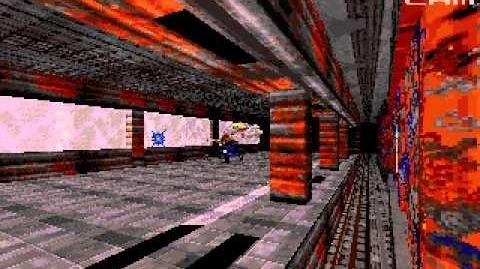
Duke Nukem 3D Beta 1995-05-09
May 10, 1995 @ 2:12:54
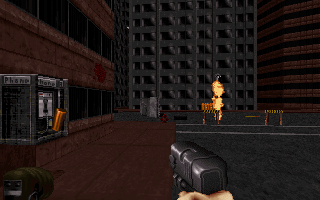
Starting location on L6, as seen in this video
May 10, 1995 @ 2:20:00

Near the start of Warp Factor, as seen in this video
May 10, 1995 @ 2:20:32

Unidentified. Most likely Warp Factor, since the layout of the room cannot be matched to contemporary map schematics from AHB-Space
May 10, 1995 @ 2:23:06
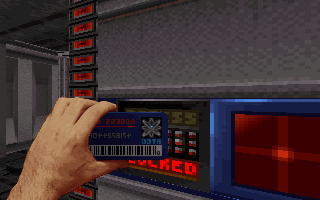
Area on Warp Factor (seen in this video) that was repurposed on It's Impossible
May 10, 1995 @ 2:24:02
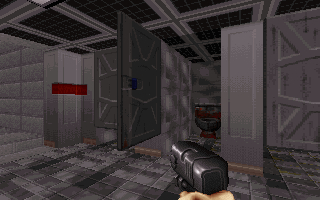
Warp Factor, as seen in this video
May 10, 1995 @ 2:30:10
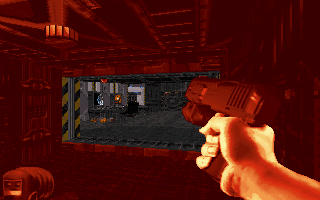
Two rooms on AHB-Space that were repurposed to create the ending of Tiberius Station
May 10, 1995 @ 2:32:24

AHB-Space, later incorporated into Lunar Reactor (see comparison)
May 18, 1995 @ 20:31:48
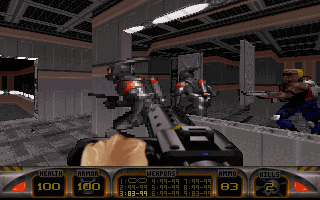
AHB-Space, as seen in this map and later incorporated into Lunar Reactor; first instance of the green HUD
May 18, 1995 @ 20:36:24

Dark Side; the inside of this structure can be seen here [Note: There is reason to think this may have been developed separately on N3 before later being absorbed into Dark Side]
May 21, 1995 @ 21:32:02
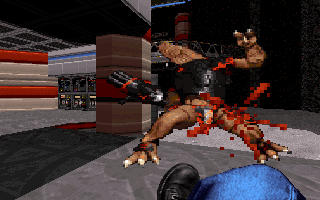
Beneath the central control tower on Dark Side
May 21, 1995 @ 21:33:32
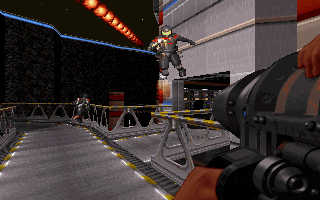
Dark Side with control panels and a chair added since previous footage; first instance of a flying Trooper; first instance of the Trooper firing a stream of projectiles; first of many instances of a colored light on the player's weapon, used to denote alternate ammo types
May 21, 1995 @ 22:43:44
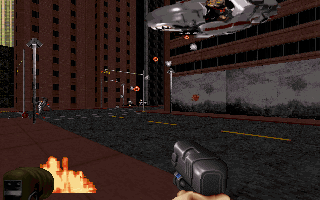
RPV piloted by an Enforcer and firing explosives on L6, between the building that would become the club (right) and adult-themed store (behind the camera) on Red Light District
May 21, 1995 @ 22:50:26

Alpha Transport on Dark Side
May 21, 1995 @ 22:52:06

Beginning of L3 (possibly corresponding to "Science Station" in 1995 episode lists) that was later copied-and-pasted onto Dark Side to create the vivisection lab; note that the player is facing the expected direction on L3 but is facing backwards on Dark Side, strongly suggesting the maps are still separate
May 21, 1995 @ 22:57:04
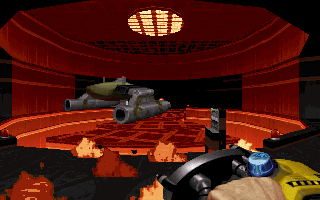
First instance of the Flamethrower with a blue light, firing at a LameDuke Drone on Dark Side
May 21, 1995 @ 23:00:50
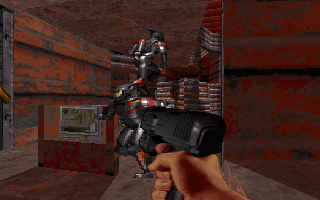
Dark Side in an area (seen in L2) that was scrapped and replaced with the starting area in the final game; there is evidence this room was likely repurposed to create the spinning water turbines on Fusion Station
May 21, 1995 @ 23:11:00

Dark Side near the Beta Transport doorway
May 27, 1995 @ 14:09:32
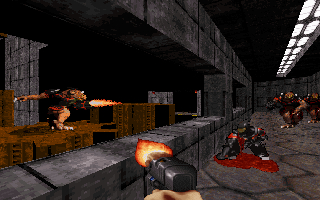
Area from the Bonaventure test map later incorporated into Death Row, where the railing is turned into a ledge; first instance where the Enforcer no longer fires blue projectiles
May 27, 1995 @ 14:15:10

Starting area of L6 that was subsumed when the adult-themed store (building in the center) was expanded into the street; individuals with privileged access to development files have confirmed this police car was directly copied-and-pasted onto Freeway
May 27, 1995 @ 15:12:46
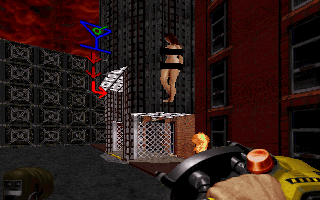
Smaller bar on L6 that did not become the bar on Red Light District; the dance floor from this bar was briefly merged (as seen here) and later fully replaced the dance floor in the main club; first instance of the Flamethrower with a red light
May 1995, unknown day
Lee Jackson, the musician who composed roughly half of the soundtrack for Duke Nukem 3D, released the following two unused music tracks. The first is an early version of "Plasma," the track that appears on Dark Side in the final game.

Original Plasma
The second is "Beehive." An early version of this track can be heard for a couple seconds during a section of the May 9, 1995 demo footage.

Beehive
The remaining screenshots come from the Bonaventure test map. A couple seconds of video footage from this map can be found in part of the May 9, 1995 demo footage. The area with the cylindrical, yellow gears was incorporated into Death Row in the final game.
This image is difficult to date.
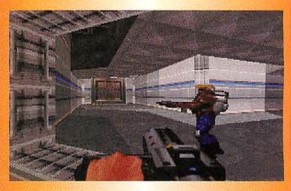
First hall on Tiberius Station, facing a mirror onto the door to the beginning of the level
Several screenshots that were packaged with the September 1995 issue of Score Magazine were dated to June, rather than May. Three of these have precise timestamps like the May screenshots, but two do not have reliable timestamps.
The two images with unreliable timestamps have copied-and-pasted messages across the tops. Several of the May screenshots also had these messages (those versions are not shown on this page), but the images with these messages included versions with and without the messages. The versions with the messages all had matching timestamps, indicating they were simultaneously processed in batches to apply the message. Therefore, it cannot be assumed that screenshots with this message across the top have reliable timestamps.
In fact, the images dated June 1 and June 30 come from batches of several images with known May dates that also had this message across the top, suggesting these two may have also come from May.
June 1, 1995
As explained, this image is dated June 1, but because the message across the top was applied as part of a batch with some of the May screenshots, this image may also come from May. However, it was the only file from this batch that did not come with a matching file without the message.
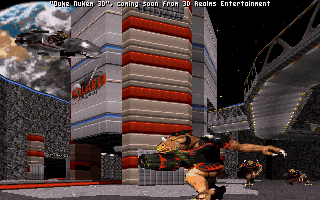
Dark Side with the "Polaris Outpost" sign taken from AHB-Space
June 4, 1995 @ 19:17:24
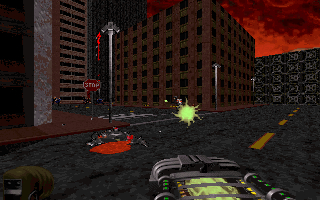
L6, facing the building that would become the adult-themed store on Red Light District with the club on the left; last instance of the flashlight
June 4, 1995 @ 19:18:40
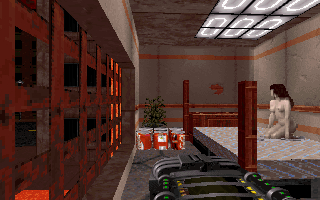
L6 in the room that would become the Blue Access Card room on Red Light District; the street can be seen right outside the window, indicating the room was closer to the ground and closer to the corner of the building; there is something resembling a lavafall outside the window
June 4, 1995 @ 19:19:32

L6, inside a scrapped hotel building seen in LameDuke; despite looking nearly identical to the screenshot above, this is actually an older fork of the same room
June 30, 1995
Similar to the June 1 image, this image has a message across the top, suggesting its timestamp may be unreliable. It was processed in a batch with several May screenshots, but unlike the others, there was no version of this image without the message.
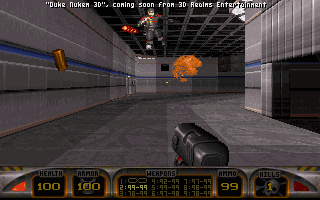
Tiberius Station with most features from the final build, including an indent in the left wall; note that the player is facing the opposite direction one would expect in the final build, possibly because sector chronology suggests the starting area may not have yet existed
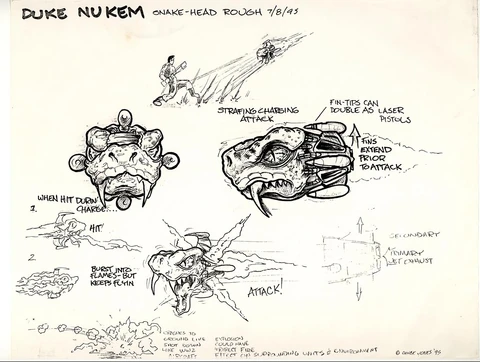
These screenshots are difficult to date. All of these maps either have not been seen in previous screenshots or have been significantly updated. Novel sprites are introduced for some of the enemies, and the Trooper's jetstream, which was once semi-transparent, is now opaque. The concept art is foreshadowing the Assault Trooper (particularly the alternate sprites used to make the Firefly Trooper), so it likely precedes the Assault Trooper's first appearance.
Police cruiser on Hollywood Holocaust; individuals with privileged access to development files have reported that no such police cruiser ever existed on the map, indicating this was a separate fork used for staging action screenshots only
Dark Side, as identified by individuals with privileged access to development files; it is not known how this was connected to the rest of the map but was most likely replaced by the massive outdoor crater (N3) or the vivisection lab (L3); because this area uses extremely rare textures that do not even appear on Dark Side in the final game, it may be noteworthy that several of these textures overlap with the room with spinning water turbines on Fusion Station, which is believed to have been adapted from a different room on early Dark Side
Warp Factor, showing the first instance of the Enforcer's slime attack
Battlelord without a gun, standing in front of a massive drill; beta storylines for the game consistently mention that the aliens came to Earth to harvest energy and cause environmental catastrophe
Dark Side, with changes from previous footage
One image dated August 6 was leaked from a verified source. Another seven images were directly posted to the Internet by the developers. Because these screenshots were directly posted to the Internet without the delays associated with printing or publishing, these screenshots are likely representative of the build at that time.
These screenshots depict an updated HUD, and the colored lights that appear on the player's weapon now appear beside the ammo in the HUD.
August 6, 1995
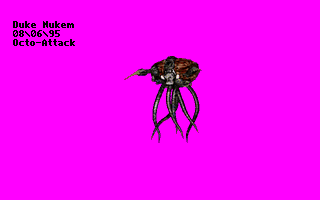
Last instance of the Jellyfish
August 11, 1995
Top floor of Spaceport; note the unusual ceiling pattern that was forked to create the hallway past the drinking fountain near the beginning of the map
Lunar Reactor; a scrapped room that connects to the ventilation shaft in the ceiling can be seen across the hall from the Red Access Card door; the room past the Yellow Access Card door is shaped differently; the sector chronology of Lunar Reactor shows the bathroom, barracks, stairwell before the reactor (but not the room with the Battlelord Sentries), room overlooking the reactor room, reactor room itself, and exploding hallway past the reactor are all older than the yellow gear in this image, indicating they all would have been present at this time
Dark Side with the first appearance of blue stripes instead of red; a Laser Tripbomb can be seen in the bottom-left corner
L6, between the buildings that would become the adult-themed store (left) and the club (right) on Red Light District
Starting area on Sweeney with much greater detail, including the first instance of the palm trees visible on the left
Except for the screenshots with HUDs, most of the images from this period are very difficult to date. One crucial assumption is that screenshots depicting blue Assault Troopers must precede green ones. This assumption is based on the observation that even many staged images later use green Assault Troopers.
Stage 1
Death Row, looking through the demolished floor in the prison block; note that the view through the hole does not even remotely approximate the lower hallway in the final build and is even missing the doors to the atrium, which sector chronology shows is the oldest part of the map
Hotel Hell, looking into a scrapped lounge at the center of the lobby (the bathroom is behind the camera)
Front entrance of the hotel on Hotel Hell, with visible features from M6
Stage 2
Launch Facility with the first instance of the updated Duke Nukem character sprite
Stage 3
The number "1" corresponding to the Mighty Foot has been removed from the HUD.
Occupied Territory in the large light-filled hallway, before section dividers were added to the hallway
Sweeney; first instance of the Octabrain; first instance of the Enforcer firing a flamethrower
Sweeney, facing away from the prison-like door on the middle floor
Occupied Territory; last instance of the Expander (the Shrinker's crystal does not turn red in this room)
Toxic Dump; first instance of the green Assault Trooper
Cutscene intended for the end of Occupied Territory; according to individuals with access to development files, this was created at a time when Occupied Territory was the final level of L.A. Meltdown
Stage 4
The entire line corresponding to the Expander has been removed from the HUD.
Early Toxic Dump (N6) in the room that was forked to create both the sunken submarine on this map and the working submarine on Death Row
Death Row; first instance of the updated Pig Cop sprites
The developers posted a collection of screenshots to the Internet on November 19, 1995. Because these screenshots were directly posted to the Internet without the delays associated with printing or publishing, these screenshots are likely representative of the build at that time.
In 2021, screenshots were leaked from a similar build that, based on the placement of the Access Cards in the HUD, must have come after the November 19 build. Individuals with access to development files have stated that these screenshots also came from a November build. In addition, the leak included map schematics for an earlier version of Red Light District, which individuals with privileged access to development files had dated to two weeks older than the other leaked screenshots. Because those map schematics can be matched to many of the screenshots below, these are all expected to come from an early November build. Moreover, the numbers in the HUD use a "stubby" font in many of these screenshots, indicating they must have come before the November 19 build.
Early November 1995

Duke Nukem 3D - Late 1995 Beta
Hollywood Holocaust; first instance of the Shotgun; according to individuals with privileged access to development files, this is the same Shotgun model as in the final build but from a different photographic angle and different coloration
Early Critical Mass, in a version of the room near the top-center of beta map schematics; the top of the screenshot reads: "Your Burning! Find Water Or Die" (sic).
Occupied Territory, in the light-filled hallway facing the doors leading to the main ring; note that the section dividers have not yet been added to the hallway
Scrapped second-floor arcade on Hollywood Holocaust, later replaced with the room where Pig Cops blast through the wall
Scrapped second-floor arcade on Hollywood Holocaust, later replaced with the room where Pig Cops blast through the wall
Scrapped men's bathroom on Hollywood Holocaust; it was dark and dingy, in contrast with the women's bathroom that had a red carpet and sofa
Early version of The Abyss with a very different layout, likely in the same location as the "San Andreas Fault" sign in the final build
Center of the main ring on Occupied Territory, where the boss fight with the Battlelord originally took place
Toxic Dump with a slightly different underwater layout
Recreation of this image from the starting area on Sweeney; dirt has been added along the top of the white wall, consistent with the final version; a red fire hydrant is visible in the background
Unidentified. Individuals with privileged access to development files have not been able to identify this; the most likely candidates include Sewer. Bank Roll (prior to adding the elevator), and Hotel Hell
Unidentified. Possibly at the beginning of the conveyor belts on Occupied Territory, at the top of the elevation, looking through a window onto an older version of the column in the center of the map, with the blue Earth in the skybox visible on either side of the column (this was voted the most likely explanation in a poll of the Duke4 Discord)
Red Light District, showing the downward ramp into the garages that were replaced by the elevator at the start of the map
Bathroom without the ventilation shaft on Hollywood Holocaust, suggesting the level was more linear
November 19, 1995
Early version of Incubator; except for the ramp, all of these textures can be found on the final build of the map, though some are in an out-of-bounds area
Warp Factor; this is a completely different room than the one at the beginning of the level, since that room existed in map blueprints from earlier builds and never had structures outside the right-hand window; the textures outside the window are also seen in this screenshot
Toxic Dump, though the dimensions of this tunnel are slightly different in the final build
Launch Facility, on a scrapped rampway wrapping around the other side of the starting room
Warp Factor, with spaceships still visible out the window and a structure that is not visible in the final build
A promotional slideshow released through 3D Realms' website on November 19, 1995 included a small collection of frequently asked questions (FAQs) with answers from developer George Broussard.
Common Duke Nukem 3D questions: Q: When will it be out? A: The offical responce is "When it's ready". We are trying for a pre-XMAS release, but will hold the game to early January if we don't think it's ready to go out. We will NOT rush the game to make some lame deadline. We are getting more and more optomistic as the days go by though. Q: What are the system requirements? A: 486 DX2/66 (local bus recommended). The basic answer is "What are you happy playing on?" We are "happy" with the above system. 8 MEGS of ram and CD will be required. Also, a CD-ROM is required for the registered version. Q: What weapons are there? A: Still tweaking and working on them, but the basic list is: Kick, High speed pistol, shotgun, 3 barrel chain gun, rocket launcher, pipe bomb with remote detonator, shrink ray (really fun), microwave assault cannon, wall mounted laser trip bomb (plant and forget). Obviously some will be held back from the shareware version. Which ones? Dunno yet. Q: How many levels are there and how big is the shareware version? A: The shareware version will be 5 levels and a secret level. 4 of the levels are going to be really fun for network play and the other two fairly large, but slanted towards single play more. The full game will have another 21 levels or so, depending on time. At least 18 though. The shareware version will likely be between 4 and 5 megs in download size. Q: Can I be a beta tester? A: No. Sorry, but we have all we need at the moment. We'll post a message if we need any more. Please let us get back to work :)
Late November 1995

Late November 1995 Prototype - Hollywood Holocaust in Duke Nukem 3D
Hollywood Holocaust; in contrast with the early November build, there is now a ventilation shaft connecting the bathroom to the projector room
Men's bathroom on Hollywood Holocaust; a crack leading to the garage from the start of the level is partially visible in the mirror
Red Light District; these next few images demonstrate that the RPV is broken and rapidly flying in circles
Red Light District, with the Pig Cops ambushing the player from behind a hidden door, rather than blasting through the ceiling
Scrapped changing room on Red Light District, with a hole in the wall leading outside the building
Old position of the Blue Access Card panel on Death Row
Old location of the Blue Access Card on Death Row; likely positioned at the end of the hallway with the explosive canisters in the final build; note that the room with the Access Card uses the same textures as those in another screenshot
Death Row in a scrapped sewer likely running through the center of the map, beneath the control center with a hologram of the Battlelord; women who use similar sprite artwork as the Femanoid are shown hanging in pods that are spraying them with slime
Tunnel from the prison cell on Death Row that leads to the sewer with hanging women
Old location of the Red Access Card panel on Death Row; note that no Access Cards were needed to complete the level, according to the individual who leaked this
Toxic Dump, showing that the buttons opened a control panel
Launch Facility; the individual who leaked this noted that this weapon behaved exactly as it does when using cheats in the leaked beta v0.99
The Abyss, showing the room that appears in the final cutscene after killing the Battlelord in the final build; the cutscene artwork was kept, even though the room was overhauled
The following is an early version of "Stalker," the music track that accompanies Hollywood Holocaust in the final game. Jackson posted the track to his personal YouTube channel, noting that the only significant differences from the final version can be heard at the 1:52 mark and 2:00 mark. Although Jackson dated the track to 1995, he did not provide enough information to approximate a more precise date. The earliest screenshots of Hollywood Holocaust can be roughly dated to sometime in the summer of 1995, and because Hollywood Holocaust had not yet been split-off from E1L6 of LameDuke as of the May 9 demo reel, the earliest possible timing is May 1995.
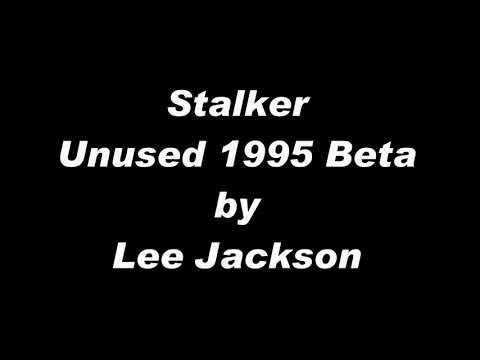
Stalker - Unused 1995 Beta
Unidentified. Individuals with privileged access to development files have been unable to identify this; the most likely candidates include the beginning of Sewer, the beginning of Bank Roll (which originally followed Hotel Hell and may have had the "Motel" callback on the left replaced with the callback crack in the wall from Raw Meat), and Hotel Hell
Hotel Hell, though details in the background are different
Duke Nukem 3D v0.99 Beta was compiled on January 4, 1996. The image below, which first appears on a screen following the defeat of the Battlelord in beta version 0.99, is from a staging map that was separate from the most recent version of Dark Side. This is known because the stripes on the building are red, which would date it before the August screenshots, yet this image also contains the newer character sprites for Duke, which would date it after the August screenshots.
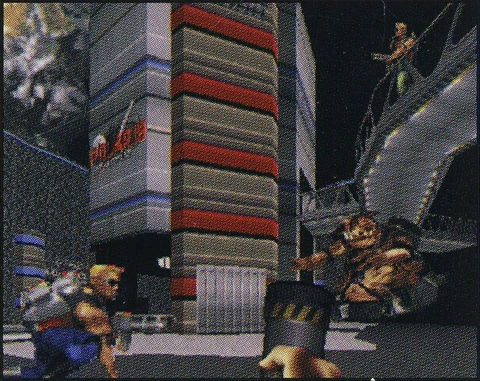
The prototype, which is publicly available to download, contains notable differences in the layouts on all maps of L.A. Meltdown, as well as a different roster of levels for the other two episodes. However, only L.A. Meltdown is accessible as part of the leaked shareware.
Shareware v1.0 was compiled on January 29, 1996. It contains minor differences in weapon behavior, enemy health, and sprite graphics from the final version. Only L.A. Meltdown was finished and available to play.
Warp Factor, showing "Tiberius Station" signage; note that "Tiberius Station" is a reference to Star Trek and that the entire map schematics of Warp Factor are shaped like the starship from Star Trek, in addition to having a secret command center from Star Trek
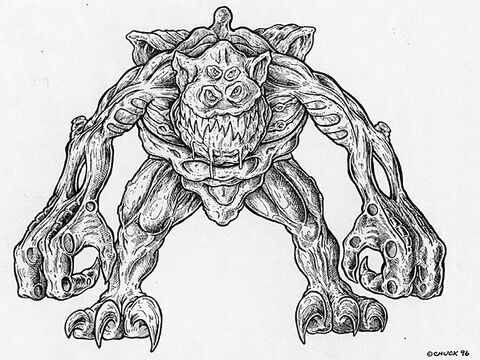
Possibly an early concept for the Overlord
Shareware v1.1 was compiled on February 20, 1996. This version is nearly identical to the final, except that the Freezethrower or Devastator had not yet been introduced. Also, a few sprites, such as switches and rocket projectiles, had not yet been updated.
This animated sprite likely precedes the implementation of the Overlord's hitscan attack, which is known to have been implemented in the non-shareware version of the Computer Gaming World Demo of the game that was compiled on March 4.
The Computer Gaming World Demo, long known by the nickname "Shareware v1.1+" in online forums, was compiled on March 4, 1996. At this stage of development:
There is not enough information to date this image. Because it depicts multiple Battlelord Sentries, it likely came after the earlier screenshots where only one is depicted on Occupied Territory, thus providing a lower bound for the date range. However, the screenshot appears to be from a very early version of Overlord, a level that dates back to LameDuke, so there is not enough information to determine an upper bound.
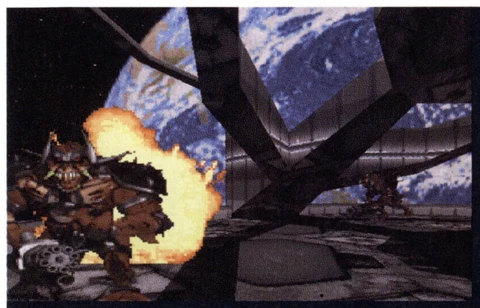
Top floor of Spaceport, sometime between the May and August iterations
 First appearance of the Devastator, which was briefly called the "Pulverizer" | 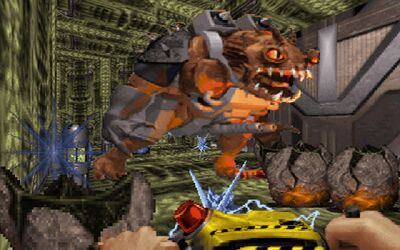 Close-up of the Overlord; first instance of the Freezethrower |
The following collection of map schematics were shared online by an individual with privileged access to development files, attempting to resolve a decades-old question about the authorship of certain maps in the game.
The first four images provide crucial information about a longstanding controversy over the authorship of Pigsty. It has long been known that Richard "Levelord" Gray contributed to several levels from The Birth, but for reasons that are unclear, he was never credited for his work on any of them (see The Birth#Disputed authorship for more information). The most hotly debated of these was Pigsty, which Gray cited as his favorite level and "99.44%" his own work. However, the map was ultimately credited solely to Randy Pitchford, whose initials appear on the map in the final version.
The map blueprints below seem to argue strongly in Gray's favor. Although it is unknown whether any of these iterations were modifications by Pitchford in which he failed to remove Gray's signature, the last two versions clearly show that negligible changes were made when Gray's signature ("SUYT" in the top-right corner) was removed from the map.
 Early build of Pigsty |  Later build of Pigsty | 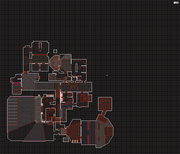 Last build of Pigsty with Gray's signature | 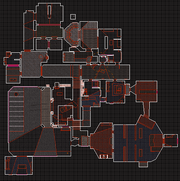 Final build from one month later, where Pitchford replaced Gray's signature with his own (not visible in this screenshot) |
The following maps also contain Gray's signature:
 Early build of Shop-N-Bag |  Later build of Shop-N-Bag |  Early build of XXX-Stacy, titled "El Segundo" in the development files |  Later build of XXX-Stacy, which happens to be the last iteration with Gray's signature |
 Early build of Fahrenheit; individuals with privileged access to development files shared that this map was started very close to the commercial release |  Later build of Fahrenheit dated one month before the commercial release |  Early build of Critical Mass; this map has a development history extending back to M5 and was briefly transformed into a space-themed level at one point |  Early build of Flood Zone; named "MONICA.MAP" in the development files; it was long believed that a map named "Santa Monica Pier" (listed in the CON files of early shareware) corresponded to an early version of Flood Zone |
 Movie Set; the scrapped area shown in the thumbnail is accessible in the final build using the no-clip cheat |  Another view of the same build of Movie Set but with more visible details |  Later build of Movie Set |
The following maps all come from early builds of Hotel Hell. The person who shared these images noted that, except for the comparison images from LameDuke and the commercial version, none of these builds contains the swimming pool.
 |  Early build of Hotel Hell |  Later build |  Final build |
 |  Early build of Hotel Hell |  Later build |  Final build |
 Downstairs bar area, with the bathroom behind the camera |  Back alley; the player would have started in the garage |
The following two maps are signed "LEE" and are believed to have been authored by soundtrack composer Lee Jackson. One individual with privileged access to development files stated that most of the level is "around average mid-90s usermap quality." Because the rest of the map is comparatively more "abstract," the individual is unsure whether the realistic mail truck that appears at the beginning of the level was designed by the same author or possibly by a different developer on the team. These maps correspond to two iterations of Going Postal, which was further developed by Allen Blum and packaged with the Atomic Edition.
See Also: Duke Nukem 3D v1.2
April 4, 1996
Jackson released the following unused track titled "233.778C" that was dated April 4, 1996 and intended to accompany Fahrenheit.
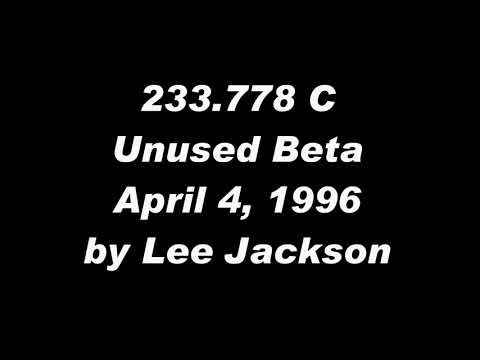
233.778C 0406
Version 1.2

Loading screen for version 1.2

Stadium in version 1.2
Individuals with privileged access to development files have shared the following information about the contents of version 1.2:
Version 1.2+
Stadium with sloped bleachers, as shown in a guidebook in which all other levels match their final versions
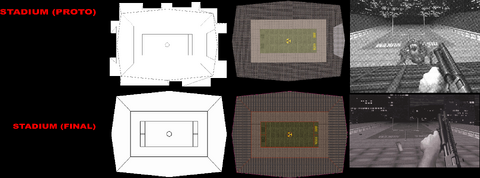
Map comparison, across versions
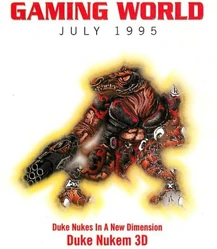
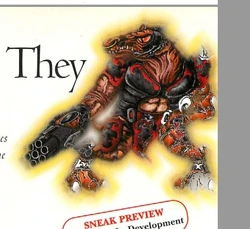
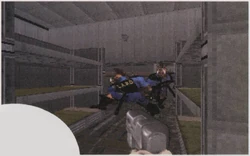
![95-06FebApr-03.png (2.92 MB) Inside a structure at the center of the crater on Dark Side (see map) [Note: There is reason to think this may have been developed separately on N3 before later being absorbed into Dark Side]](https://static.wikia.nocookie.net/dukenukem/images/3/3f/95-06FebApr-03.png/revision/latest/scale-to-width-down/227?cb=20210322210752)
![95-06FebApr-04.png (697 KB) Duke Nukem II checkpoint on Dark Side (compare to Duke Nukem II sprite; the white horizontal line is actually a ledge in the distance) [Note: There is reason to think this may have been developed separately on N3 before later being absorbed into Dark Side]](https://static.wikia.nocookie.net/dukenukem/images/4/4c/95-06FebApr-04.png/revision/latest/scale-to-width-down/250?cb=20210322210757)
![95-06FebApr-05.png (272 KB) Far corner after dropping down the elevation near the end of Dark Side, facing the elevation with a box on the left [Note: There is reason to think this may have been developed separately on N3 before later being absorbed into Dark Side]](https://static.wikia.nocookie.net/dukenukem/images/a/a0/95-06FebApr-05.png/revision/latest/scale-to-width-down/250?cb=20210322210759)
